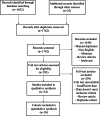Radiotherapy versus combination radiotherapy-bevacizumab for the treatment of recurrent high-grade glioma: a systematic review
- PMID: 33796887
- PMCID: PMC8195900
- DOI: 10.1007/s00701-021-04794-3
Radiotherapy versus combination radiotherapy-bevacizumab for the treatment of recurrent high-grade glioma: a systematic review
Abstract
Background: High-grade gliomas (HGG) comprise the most common primary adult brain cancers and universally recur. Combination of re-irradiation therapy (reRT) and bevacizumab (BVZ) therapy for recurrent HGG is common, but its reported efficacy is mixed.
Objective: To assess clinical outcomes after reRT ± BVZ in recurrent HGG patients receiving stereotactic radiosurgery (SRS), hypofractionated radiosurgery (HFSRT), or fully fractionated radiotherapy (FFRT).
Methods: We performed a systematic review of PubMed, Web of Science, Scopus, Embase, and Cochrane databases, following the Preferred Reporting Items for Systematic Reviews and Meta-Analyses (PRISMA) guidelines. We identified studies reporting outcomes for patients with recurrent HGG treated via reRT ± BVZ. Cohorts were stratified by BVZ treatment status and re-irradiation modality (SRS, HFSRT, and FFRT). Outcome variables were overall survival (OS), progression-free survival (PFS), and radiation necrosis (RN).
Results: Data on 1399 patients was analyzed, with 954 patients receiving reRT alone and 445 patients receiving reRT + BVZ. All patients initially underwent standard-of-care therapy for their primary HGG. In a multivariate analysis that adjusted for median patient age, WHO grade, RT dosing, reRT fractionation regimen, time between primary and re-irradiation, and re-irradiation target volume, BVZ therapy was associated with significantly improved OS (2.51, 95% CI [0.11, 4.92] months, P = .041) but no significant improvement in PFS (1.40, 95% CI [- 0.36, 3.18] months, P = .099). Patients receiving BVZ also had significantly lower rates of RN (2.2% vs 6.5%, P < .001).
Conclusions: Combination of reRT + BVZ may improve OS and reduce RN rates in recurrent HGG, but further controlled studies are needed to confirm these effects.
Keywords: Astrocytoma; Bevacizumab; Glioblastoma; Glioma; Radiosurgery; Radiotherapy; Recurrent.
Conflict of interest statement
The authors declare no conflict of interest.
Similar articles
-
Efficacy and safety of combining re-irradiation with bevacizumab compared to bevacizumab alone in the management of recurrent high-grade gliomas: a meta-analysis and systematic review.Ther Adv Neurol Disord. 2025 Jun 14;18:17562864251343574. doi: 10.1177/17562864251343574. eCollection 2025. Ther Adv Neurol Disord. 2025. PMID: 40529988 Free PMC article.
-
Interventions for the treatment of brain radionecrosis after radiotherapy or radiosurgery.Cochrane Database Syst Rev. 2018 Jul 9;7(7):CD011492. doi: 10.1002/14651858.CD011492.pub2. Cochrane Database Syst Rev. 2018. PMID: 29987845 Free PMC article.
-
Reirradiation versus systemic therapy versus combination therapy for recurrent high-grade glioma: a systematic review and meta-analysis of survival and toxicity.J Neurooncol. 2023 Sep;164(3):505-524. doi: 10.1007/s11060-023-04441-0. Epub 2023 Sep 21. J Neurooncol. 2023. PMID: 37733174 Free PMC article.
-
Taxane monotherapy regimens for the treatment of recurrent epithelial ovarian cancer.Cochrane Database Syst Rev. 2022 Jul 12;7(7):CD008766. doi: 10.1002/14651858.CD008766.pub3. Cochrane Database Syst Rev. 2022. PMID: 35866378 Free PMC article.
-
Intraoperative 5-ALA fluorescence-guided resection of high-grade glioma leads to greater extent of resection with better outcomes: a systematic review.J Neurooncol. 2022 Jan;156(2):233-256. doi: 10.1007/s11060-021-03901-9. Epub 2022 Jan 6. J Neurooncol. 2022. PMID: 34989964
Cited by
-
Low-Dose Apatinib Improves the Prognosis of Patients with Recurrent High-Grade Gliomas.Evid Based Complement Alternat Med. 2022 Sep 5;2022:3181133. doi: 10.1155/2022/3181133. eCollection 2022. Evid Based Complement Alternat Med. 2022. Retraction in: Evid Based Complement Alternat Med. 2023 Jun 21;2023:9853753. doi: 10.1155/2023/9853753. PMID: 36106030 Free PMC article. Retracted.
-
Direct antitumor activity of bevacizumab: an overlooked mechanism?Front Pharmacol. 2024 Apr 23;15:1394878. doi: 10.3389/fphar.2024.1394878. eCollection 2024. Front Pharmacol. 2024. PMID: 38716237 Free PMC article. No abstract available.
-
Phase II study of border zone stereotactic radiosurgery with bevacizumab in patients with recurrent or progressive glioblastoma multiforme.J Neurooncol. 2023 Aug;164(1):179-190. doi: 10.1007/s11060-023-04398-0. Epub 2023 Jul 29. J Neurooncol. 2023. PMID: 37515669 Clinical Trial.
-
Radiotherapy of High-Grade Gliomas: First Half of 2021 Update with Special Reference to Radiosensitization Studies.Int J Mol Sci. 2021 Aug 19;22(16):8942. doi: 10.3390/ijms22168942. Int J Mol Sci. 2021. PMID: 34445646 Free PMC article. Review.
-
Bevacizumab combined with re-irradiation in recurrent glioblastoma.Front Oncol. 2022 Aug 4;12:961014. doi: 10.3389/fonc.2022.961014. eCollection 2022. Front Oncol. 2022. PMID: 36046037 Free PMC article.
References
Publication types
MeSH terms
Substances
LinkOut - more resources
Full Text Sources
Other Literature Sources
Medical


